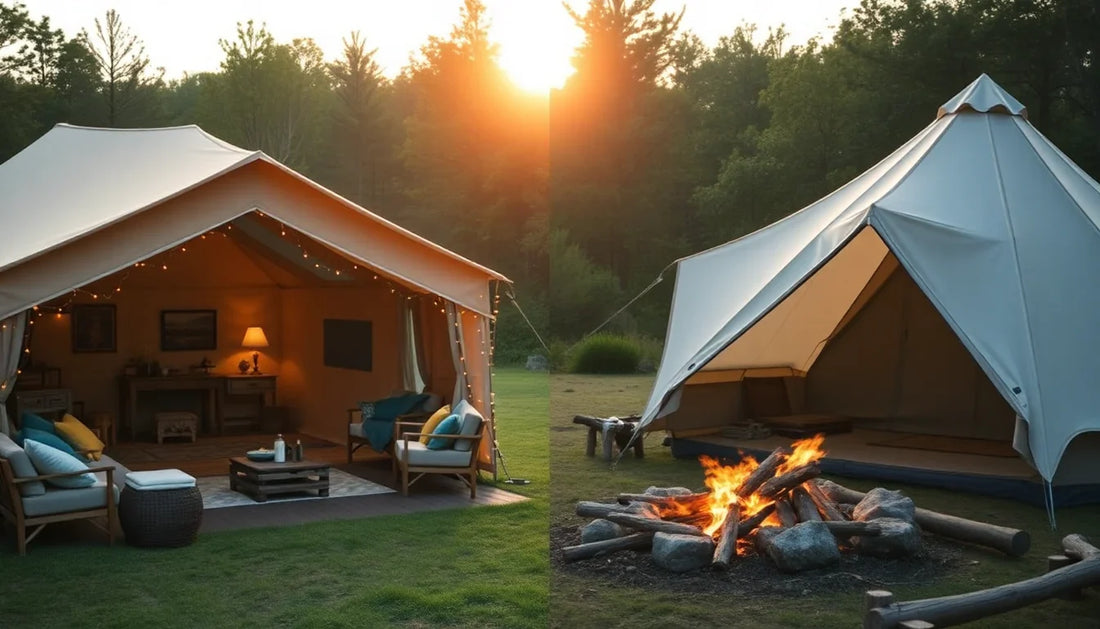
Glamping vs Traditional Camping: Pros, Cons, and What to Expect
Share
As the world becomes increasingly fast-paced and technology-driven, the desire for authentic outdoor experiences has grown exponentially. Two distinct camping styles have emerged to cater to this need - traditional camping and glamping. While both offer the opportunity to connect with nature, the experiences they provide are vastly different. In this blog post, we'll explore the pros and cons of each, as well as what you can expect from each type of camping adventure.
Traditional Camping: The Classic Outdoor Experience
Traditional camping is the quintessential outdoor adventure, where you pack your gear, pitch a tent, and immerse yourself in the natural world. This style of camping requires a certain level of skill and preparation, from navigating the wilderness to setting up your campsite. The equipment needed is relatively basic - a sturdy tent, sleeping bag, camping stove, and the essentials for cooking and staying comfortable.
The beauty of traditional camping lies in its authenticity. You'll be surrounded by the sights, sounds, and smells of nature, with minimal interference from modern conveniences. This level of immersion can be incredibly rejuvenating, allowing you to disconnect from the stresses of everyday life and reconnect with the great outdoors. The cost of traditional camping is also generally lower than glamping, making it an accessible option for those on a tighter budget.
However, traditional camping does come with its own set of challenges. Setting up camp, cooking meals, and maintaining cleanliness can be physically demanding, especially for those new to the experience. The lack of amenities, such as running water and electricity, can also be a deterrent for some. Additionally, the unpredictable nature of the weather and the potential for encountering wildlife can add an element of uncertainty to the trip.
Glamping: Luxury Meets Nature
Glamping, a portmanteau of "glamorous" and "camping," offers a more luxurious approach to outdoor adventures. Instead of a basic tent, glampers can expect to find a range of accommodation options, from safari-style tents and yurts to fully-equipped cabins and treehouses. These accommodations often come with amenities such as plush bedding, en-suite bathrooms, and even Wi-Fi connectivity.
The appeal of glamping lies in its ability to provide the comforts of home while still allowing for a connection with nature. Glampers can enjoy the beauty of the great outdoors without sacrificing the conveniences they're accustomed to. This style of camping is particularly attractive to those who may be hesitant about the more rugged aspects of traditional camping, as well as families with young children or individuals with mobility challenges.
The cost of glamping is generally higher than traditional camping, as the accommodations and amenities come at a premium. However, many glamping sites offer a range of packages and options to suit different budgets. Additionally, the level of service and attention to detail provided by glamping operators can make the higher price tag feel justified.
Pros and Cons Comparison
To help you decide which camping style is right for you, let's take a closer look at the pros and cons of each:
Traditional Camping
Pros:
- Immersive outdoor experience
- Opportunity to develop camping skills
- Lower cost compared to glamping
- Closer connection to nature
Cons:
- Physically demanding setup and maintenance
- Lack of modern amenities and comforts
- Potential for inclement weather and wildlife encounters
- Requires more preparation and planning
Glamping
Pros:
- Luxurious and comfortable accommodations
- Access to modern amenities and conveniences
- Suitable for those with limited outdoor experience
- Ideal for families and groups
Cons:
- Higher cost compared to traditional camping
- Less immersive outdoor experience
- Limited opportunity to develop camping skills
- Potential for a less authentic connection to nature
What to Expect: Experience Differences
When it comes to the actual camping experience, there are significant differences between traditional camping and glamping.
In traditional camping, you can expect a more rugged and hands-on approach. You'll be responsible for setting up your own tent, gathering firewood, and preparing meals over a campfire or portable stove. The level of physical activity and problem-solving required can be both challenging and rewarding, as you learn to adapt to the natural environment.
Glamping, on the other hand, offers a more curated and comfortable experience. Your accommodation will likely be pre-set, with plush bedding, electricity, and even running water. Meals may be provided or easily prepared using the on-site amenities. The focus is on relaxation and enjoyment, rather than the practical aspects of camping.
The level of social interaction and environmental impact also varies between the two styles. Traditional camping often fosters a sense of community, as campers share resources and experiences. Glamping, while still allowing for social interaction, may have a more insular feel, as the accommodations are often more private and self-contained.
Choosing the Right Option
When deciding between traditional camping and glamping, it's important to consider your personal preferences, budget, and the level of adventure you're seeking.
If you're an experienced outdoor enthusiast who relishes the challenge of setting up camp and living off the grid, traditional camping may be the perfect choice. It offers a more immersive and authentic experience, allowing you to truly connect with nature and develop valuable camping skills.
On the other hand, if you're looking for a more comfortable and hassle-free outdoor experience, glamping may be the way to go. It's an excellent option for those new to camping, families with young children, or individuals who prefer a higher level of amenities and service.
Ultimately, the decision comes down to your individual needs and expectations. Both traditional camping and glamping offer unique and rewarding experiences, and trying both can be a great way to discover your preferred camping style.
Conclusion
As the popularity of outdoor adventures continues to grow, the debate between traditional camping and glamping shows no signs of slowing down. Each style offers its own set of benefits and drawbacks, catering to different preferences and needs.
Whether you choose to embrace the rugged simplicity of traditional camping or indulge in the luxurious comforts of glamping, the key is to approach your outdoor experience with an open mind and a spirit of adventure. By understanding the differences between these two camping styles, you can make an informed decision and embark on a truly memorable journey in nature.
So, pack your bags, lace up your hiking boots, and get ready to explore the great outdoors - whether it's in a cozy glamping tent or under the stars in a traditional campsite.
